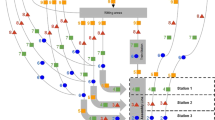Abstract
Since the advent of just-in-time driven production planning and control at the Toyota manufacturing plants, the just-in-time paradigm has considered wide-spread consideration within production and operations management (cf., e.g., Schniederjans [22] and Cheng and Podolski [5]). While it was first employed for the high-volume-production of goods only, later there has been considerable research in the area of low-volume, make-to-order manufacturing (cf., e.g., Baker and Scudder [2], Neumann et al. [18], and Rachamadugu [21]). Agrawal et al. [1] considered a practical scheduling problem at Westinghouse ESG, where a number of customer-specific products have to be assembled subject to technological precedence and capacity constraints. The authors developed a MIP-formulation and — in the face of the NP-hardness of the problem — a ‘lead time evaluation and scheduling algorithm’ with acronym LETSA.
Access this chapter
Tax calculation will be finalised at checkout
Purchases are for personal use only
Preview
Unable to display preview. Download preview PDF.
Similar content being viewed by others
References
Agrawal A, Harhalakis G, Minis I, Nagi R (1996) Just-in-time production of large assemblies. HE Transactions 28:653–667
Baker KR, Scudder GD (1990) Sequencing with earliness and tardiness penalties: A review. Operations Research 38(1):22–36
Błażewicz J, Lenstra JK, Rinnooy Kan AHG (1983) Scheduling subject to resource constraints: Classification and complexity. Discrete Applied Mathematics 5:11–24
Brucker P, Drexl A, Möhring R, Neumann K, Pesch E (1999) Resource-constrained project scheduling: Notation, classification, models, and methods. European Journal of Operational Research 112(1):3–41
Cheng TCE, Podolsky S (1993) Just-in-Time Manufacturing — An Introduction. Chapman & Hall, London
Christofides N, Alvarez-Valdés R, Tamarit JM (1987) Project scheduling with resource constraints: A branch and bound approach. European Journal of Operational Research 29:262–273
Davis EW, Patterson JH (1975) A comparison of heuristic and optimum solutions in resource-constrained project scheduling. Management Science 21:944–955
Demeulemeester EL, Herroelen WS (2002) Project Scheduling — A Research Handbook. Kluwer Academic Publishers, Boston
Drexl A (1990) Fließbandaustaktung, Maschinenbelegung und Ka-pazitätsplanung in Netzwerken: Ein integrierender Ansatz. Zeitschrift für Betriebswirtschaft 60(1):53–69
Elmaghraby SE (1977) Activity Networks: Project Planning and Control by Network Models. Wiley, New York
Hartmann S, Kolisch R (2000) Experimental evaluation of state-of-the-art heuristics for the resource-constrained project scheduling problem. European Journal of Operational Research 127:394–407
Kelley JE (1963) The critical-path method: Resources planning and scheduling. In: Muth JF, Thompson GL (eds.) Industrial Scheduling. Prentice-Hall, New Jersey, pp. 347–365
Kolisch R (1996) Serial and parallel resource-constrained project scheduling methods revisited: Theory and computation. European Journal of Operational Research 90:320–333
Kolisch R (2001) Make-to-Order Assembly Management. Springer, Berlin
Kolisch R, Hartmann S (1999) Heuristic algorithms for the resource-constrained project scheduling problem: Classification and computational analysis. In: Weglarz J (ed.) Project Scheduling — Recent Models, Algorithms and Applications. Kluwer Academic Publishers, Boston, pp. 147–178
Kolisch R, Hartmann S (2005) Experimental evaluation of heuristics for the resource-constrained project scheduling problem: An update. European Journal of Operational Research, in press.
Neumann K, Schwindt C, Trautmann N (2002) Advanced production scheduling for batch plants in process industries. OR Spektrum 24:251–279
Neumann K, Schwindt C, Zimmermann J (2003) Project Scheduling with Time Windows and Scarce Resources, 2. edition. Springer, Berlin
Pinson E, Prins C, Rullier F (1994) Using tabu search for solving the resource-constrained project scheduling problem. In: Proceedings of the 4. International Workshop on Project Management and Scheduling, Leuven, pp. 102–106
Pritsker AAB, Watters LJ, Wolfe PM (1969) Multiproject scheduling with limited resources: A zero-one programming approach. Management Science 16:93–107
Rachamadugu R (1995) Scheduling jobs with proportionate early/tardy penalties. HE Transactions 27:679–682
Schniederjans MJ (1993) Topics in Just-in-Time Management. Allyn and Bacon, Boston
Sprecher A (1994) Resource Constrained Project Scheduling — Exact Methods for the Multi-Mode Case, volume 1994 of Lecture Notes in Economics and Mathematical Systems. Springer, Berlin
Sprecher A, Kolisch R, Drexl A (1995) Semi-active, active, and non-delay schedules for the resource-constrained project scheduling problem. European Journal of Operational Research 80:94–102
Valls V, Ballestin F, Quintanilla MS (2003) A hybrid genetic algorithm for the RCPSP. Technical report, Department of Statistics and Operations Research, University of Valencia
Author information
Authors and Affiliations
Editor information
Rights and permissions
Copyright information
© 2006 Deutscher Universitäts-Verlag/GWV Fachverlage GmbH, Wiesbaden
About this chapter
Cite this chapter
Kolisch, R. (2006). Just-in-Time Production of Large Assemblies Using Project Scheduling Models and Methods. In: Morlock, M., Schwindt, C., Trautmann, N., Zimmermann, J. (eds) Perspectives on Operations Research. DUV. https://doi.org/10.1007/978-3-8350-9064-4_12
Download citation
DOI: https://doi.org/10.1007/978-3-8350-9064-4_12
Publisher Name: DUV
Print ISBN: 978-3-8350-0234-0
Online ISBN: 978-3-8350-9064-4
eBook Packages: Business and EconomicsBusiness and Management (R0)




